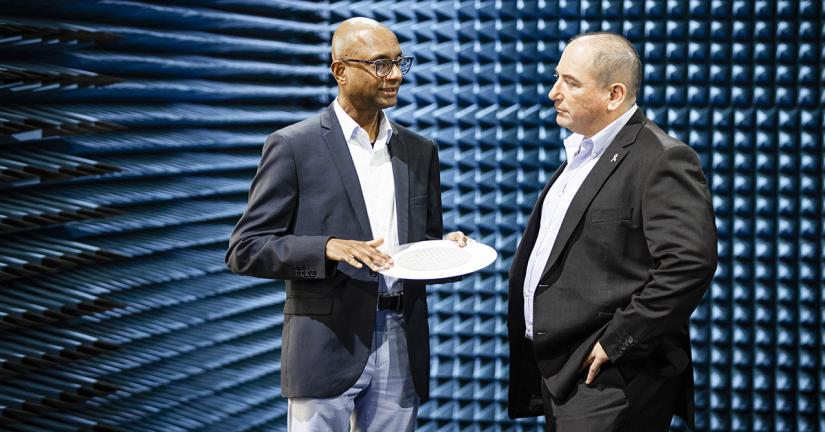Australian-first communications technology is behind a new satellite terminal that will provide affordable and reliable internet connection to even the remotest communities.

UTS Professor Karu Esselle and David Benchoam from Benelec. Photo Andy Roberts
The BeSAT100 satellite communications terminal, believed to be the world’s most energy efficient of its kind, has a compact flat-panelled antenna system that can operate off-grid on a portable battery.
It can be easily transported and make connections with satellites in minutes, making it ideal for reconnecting areas cut off during a natural disaster or blackout.
“In initial satellite tracking field tests, our new terminal demonstrated peak power consumption that is significantly lower than current state-of-the-art satellite terminals, while matching their connectivity strength,” says Distinguished Professor Karu Esselle who is leading the UTS team developing the innovative technology.
“This level of energy efficiency makes it more environmentally friendly and cheaper to run, allowing us to run our unit off smaller batteries and make it even easier to transport to hard-to-reach locations.”
“The terminal system can be set up within hours to provide reliable data access through the OneWeb Low Earth Orbit satellite network for emergency services staff and isolated communities following natural disasters. It can operate off batteries or solar panels for many hours and sometimes even around the clock in areas where there’s no power grid.”
The terminal is being commercialised by Australian radio technology company Benelec, which was recently awarded $1.15 million in funding from the Australian Government’s Telecommunications Disaster Resilience Innovation program to manufacture a ready-to-sell prototype and commercialise it.
“At the end of day, we want a terminal that’s practical to build in Australia almost entirely, cost-effective and can be marketed for use in remote communities across Australia,” says Benelec General Manager, David Benchoam.
The key point of difference with our BeSAT100 satellite terminal is it uses very little power to run.
David Benchoam, Benelec
"This makes it an ideal solution for remote Indigenous communities, for example. We worked with groups in the Torres Strait in the past to find solutions for them to access high-speed data when they don’t have any. This unit could be perfect for their needs.”
“For people working in emergency services, they can have a terminal on the back of a trailer which they can pull up to a location where there’s a bushfire or flood and it’ll give them access to a network where there is none.”
“We also see applications in mining and agriculture where a fixed unit can be placed in remote locations that need reliable data access.”
The project team had previously been awarded $1.1 million to develop the existing prototype through the NSW Government’s Small Business Innovation and Research Program administered by the Office of the NSW Chief Scientist and Engineer.
Professor Esselle says the BeSAT100 is based on a number of world-leading technical breakthroughs his team has made in antenna technology. He is also partnering with satellite operator OneWeb on the data connections.
“Our antennas can more efficiently capture satellite signal beams than existing systems. We have developed a ‘flat-thin panel’ configuration which minimises the chances of one of the panels blocking the signal to the other,” he says.
The technology is also fully Australian owned and can be manufacturing using existing local-sourced parts providing certainty around the supply chain and creating jobs in Australia.

